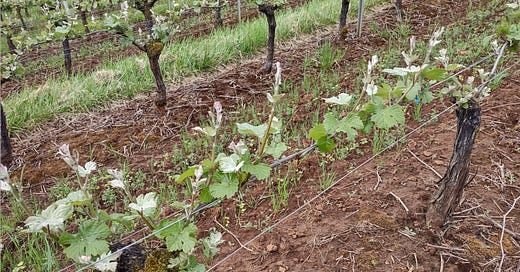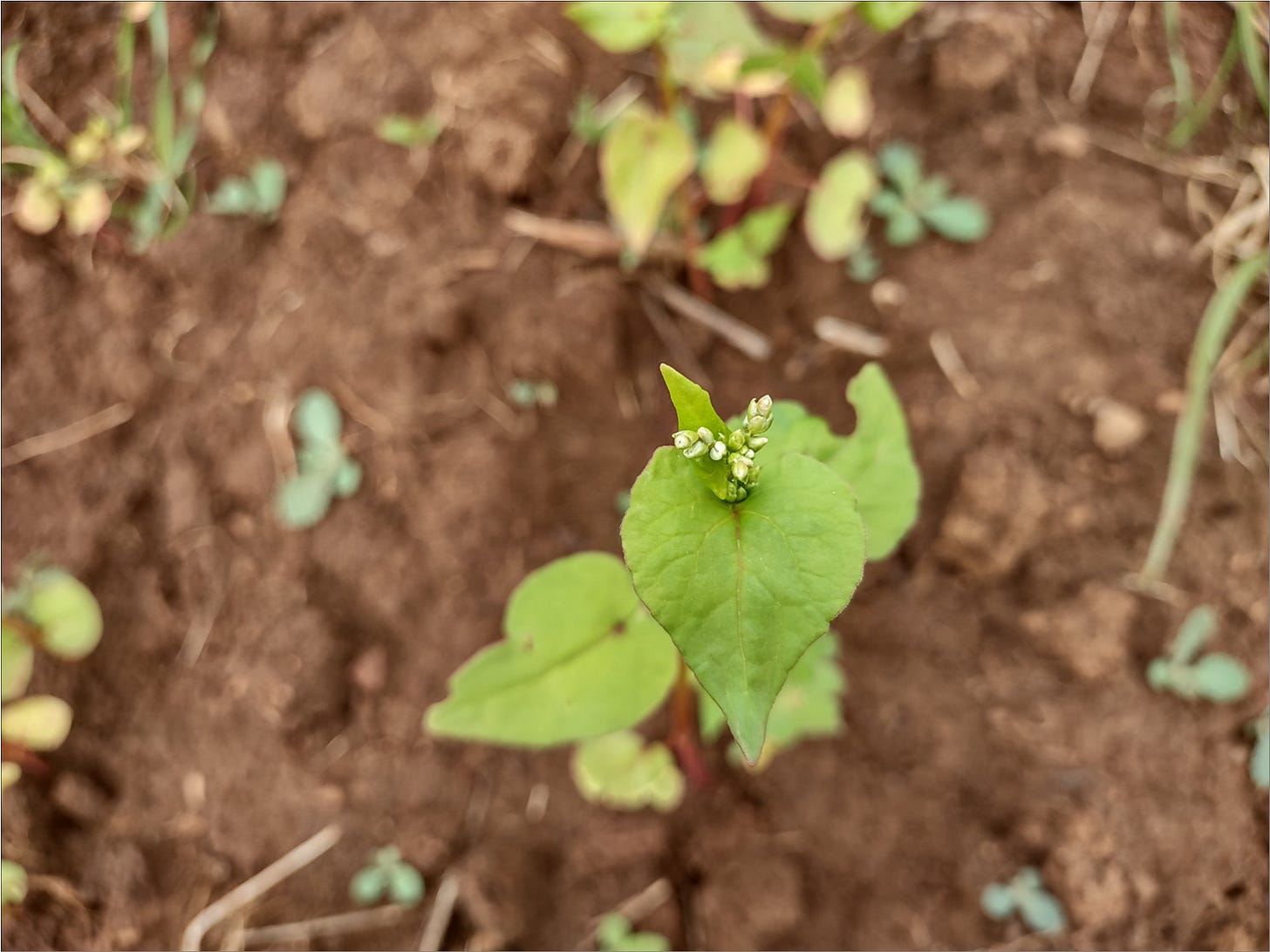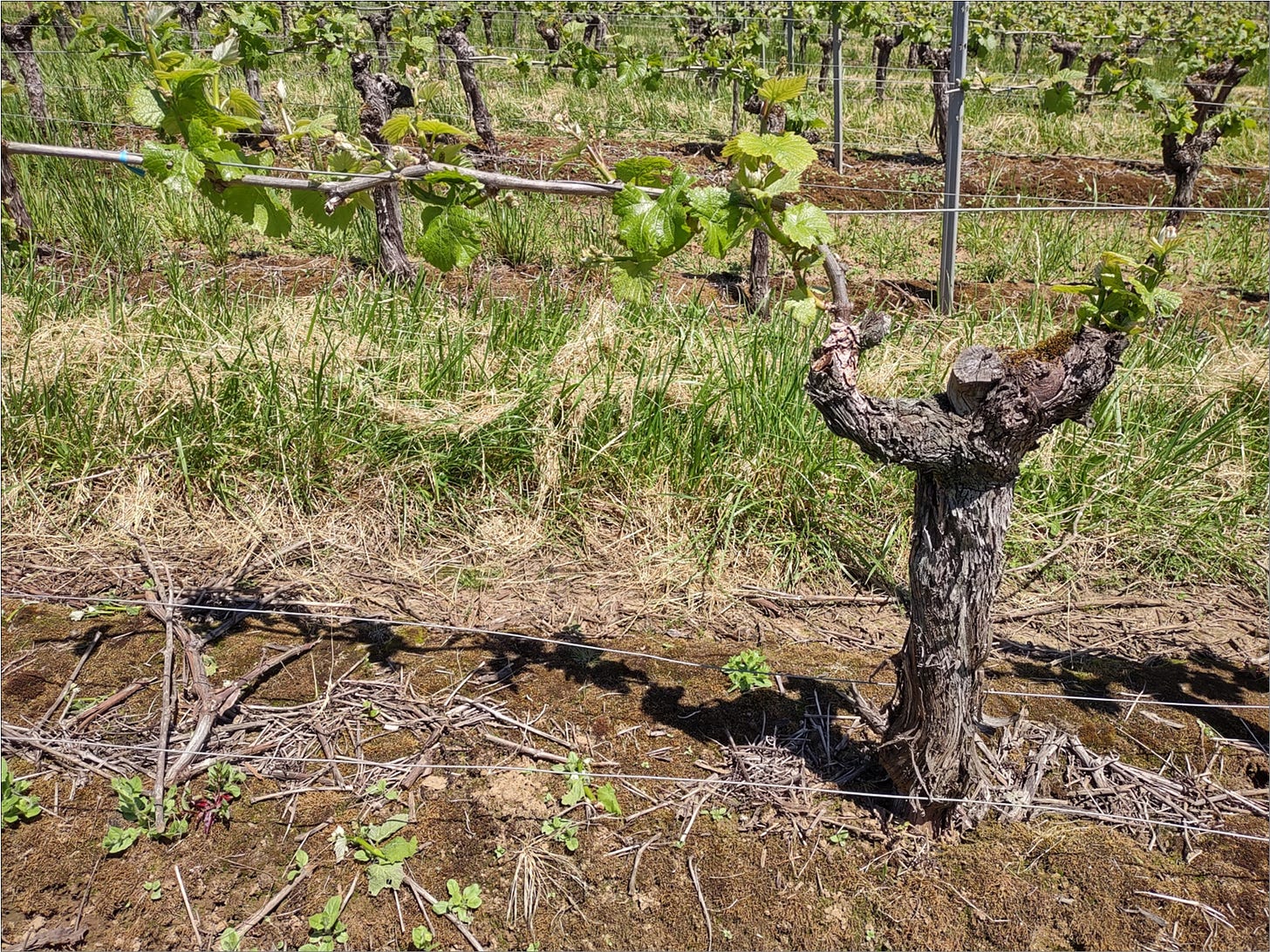Amalie Robert Estate Climate Update: May 2022 and AVA Final Rule
Hello and Welcome,
This is the “Cold Shoulder” Vintage 2022 May Climate Update and AVA Final Rule.
The month of May extended April’s soggy Willamette Valley wine country spring. Dog nose weather, cold and wet. Except we had a little more rain in May than April, but less frost and hail. We will take what we can get. The cool temperatures in May kept a lid on the vine’s development so we do not have much growth to report.
The primary buds that survived their encounter with Jack Frost are about 3 to 7 inches now. And here is the often referred to, but never actually seen in agriculture, silver lining - we have very little frost damage to report. The targeted varietal seems to have been Gewurztraminer, where we estimate a 50% loss of primary buds. Our next big calamity comes when the vines flower and that should be sometime in mid-June, hopefully not July. Winegrowing in the Willamette Valley, Gird up your loins!
The Big Picture
The vineyard is in very good shape as we end the month of May.
What we have here is the vineyard floor sporting a full measure of cover crop flora. Those little buckwheat and vetch seeds germinated and are packing quite a nutritional load for our soil. We consider the soil to be the plant’s stomach, and cover crops are on the menu. Our methodology is to use these cover crops to provide nutrients in the soil. The soil then feeds our vines naturally. Cover crops also provide a natural habitat for our beneficial, predatory insects. Predatory insects eat insects such as mites and cane borers that are detrimental to our vines. It is a very specific ecosystem focused on wine berry cultivation. Not everyone feeds and protects their vines this way, which leaves a question that begs to be answered.
What you do not see germinating here are the Gator seeds that Ernie brought back from Florida. Ernie thought a few little Gators would help keep down the “target species” insect population. But since he could not bring back live Gators, the nice man at the Gator farm sold Ernie some Gator seeds so he could grow his own. Gators are warm weather reptiles, so they probably just need some more heat...
And that vine is sporting a full measure of primary buds that are just waiting to grow! What you don’t see is any rubbish growing at the base of the trunk. The technical term is water sprouts, the vineyard term is suckers. Suckers steal the vines energy away from wine berry production. They can also harbor mildew and botrytis that can infect the wine berries later in the growing season. Removing suckers early is a vineyard best practice, and a smart thing to do.
And upon closer inspection you will see the inflorescence. Or in this case 2 inflorescences. This is where the action is. Given enough time, and heat, these structures will flower and become the stems holding the wine berries that we hand harvest and use for whole cluster Pinot Noir and Syrah fermentation. Machine harvesting takes the wine berry but leaves the stems behind. Once the vines flower, we are looking for about 105 days before we begin The Great Cluster Pluck. But first those inflorescences must bedangle themselves with flowers, and we are still a country mile away from there.
National Rosé Day is THIS Saturday, June 11th. Toasting to a day dedicated to Rosé with Pinot in Pink, Vintage 2021!
Tasting Notes: Vivacious Cadillac pink taunts while crushed Oregon strawberry, rose petal and cinnamon aromas invite. This wine is out for adventure, romance or conquest and whatever else it is that makes you love being you.
Culinary Inclinations: Smoked duck breast, fresh Cameo apple, Manchego cheese, crusty sourdough bread and a large blanket near a secluded creek side on a sunny afternoon.
Planning to enjoy traveling again and exploring the Willamette Valley? Amalie Robert Estate is open year-round by appointment for vineyard tours and tastings. Request a tasting appointment with your preferred day and time.
Winemaking: The Continuation of Terroir by Other Means.® by Dena & Ernie is the repository of our farming history at Amalie Robert Estate. A FLOG communication (Farming bLOG). We have over 200 posts going back some 20 years. It’s all out there. More than you would ever want to know about growing wine. Check us out on Substack. You can keep up with Vintage 2022 on our Instagram account @AmalieRobert. Estate grown, hand harvested Oregon Willamette Valley Pinot Noir, Chardonnay et al.
The Main Story: We have an AVA
Well, it finally happened. The Alcohol and Tobacco Tax and Trade Bureau, Treasury has published their Final Rule on “Mount Pisgah, Polk County, Oregon AVA.” Published on June 3rd, 2022:
“The Alcohol and Tobacco Tax and Trade Bureau (TTB) establishes the approximately 5,850-acre “Mount Pisgah, Polk County, Oregon” viticultural area in Polk County, Oregon. The viticultural area is located entirely within the existing Willamette Valley viticultural area. TTB designates viticultural areas to allow vintners to better describe the origin of their wines and to allow consumers to better identify wines they may purchase.”
The Siletz River volcanics parent material is a unique geological feature which occurs within the Mount Pisgah, Polk County, Oregon AVA but not within the remainder of the Willamette Valley AVA (Source TTB.)
Founded at the turn of this century, Amalie Robert Estate is the beneficiary of Siletz River volcanic rocks (which were sea floor mountains some 40 to 60 million years ago) that formed the parent material of Mt. Pisgah. Geologically speaking, this is some of the oldest soil in the Willamette Valley and is unique to the Mount Pisgah, Polk County, Oregon AVA. Our close proximity to this unique geological feature (just 1.25 miles due south) fueled our motivation to pursue a tightly focused AVA.
And as you may well imagine, there was a fair bit of wrangling and consternation on motivations, boundaries, and potential AVA names. At one point, Ernie was told “You are either with us or against us”. Not really the best way to “Win Friends and Influence People.”
All of that will most assuredly come out in the weeks and months ahead. For now though it is pretty clear that the AVA name suggested by the TTB (and adopted by a subset of the vineyards and wineries in hopes it could be shortened), is not changing anytime soon. Note: We were NOT a “yea” vote on the name. From the Final Rule:
Proposal To Modify Proposed AVA Name
“One comment (comment 7) supports the proposed Mount Pisgah, Polk County Oregon AVA but also suggests modifying the name. The comment claims that, while other regions known as “Mount Pisgah” exist in Oregon, those regions are not conducive to viticulture. Therefore, the comment recommends shortening the proposed name to “Mount Pisgah.” Two of the other comments support this idea of a shortened name (comments 13 and 15), with one of the comments (comment 15) noting that the other regions in Oregon known as Mount Pisgah are located on public lands and are unlikely to be available for commercial viticulture.”
TTB Response
“One of the purposes of designating AVAs is to provide consumers more information about the origin of the grapes used to make the wine. Because there are at least three geographic features in Oregon known as “Mount Pisgah,” TTB believes that it is important to clarify to which feature the wine label refers. Although the commenters state that the proposed AVA is the only “Mount Pisgah” where viticulture takes place in Oregon, consumers might not be aware of this and might assume that the AVA name refers to one of the other regions.
Therefore, TTB believes that including the county in the proposed AVA name is necessary in order to reduce the chance of consumer confusion. Additionally, because Polk County is a common county name within the U.S., and multiple States have geographic features known as “Mount Pisgah,” TTB does not believe that shortening the proposed AVA name to “Mount Pisgah, Polk County” would sufficiently identify the proposed AVA's location. For these reasons, TTB is not considering establishing the AVA with an abbreviated shortened name.”
So, there it is. The Pig in the Polk… Oregon.
What Does This Mean and Why Should I Care?
The TTB designates viticultural areas to allow vintners to better describe the origin of their wines and to allow consumers to better identify wines they may purchase. By establishing a bounded area, the TTB is recognizing a similarity in the soil, weather and other factors that affect wine grape production within that bounded area.
The TTB does not make any claims regarding the quality of the wines produced from an AVA. It is up to each vineyard to decide how they will use their land. From rootstocks and clones to trellis design and to hand or machine harvest, there are differences among vineyards within the bounded area. Got cover crops?
For a wine to be labeled with an AVA name or with a brand name that includes an AVA name, at least 85 percent of the wine must be derived from grapes grown within the area represented by that name, among other requirements. And if it is labelled Oregon Pinot Noir, the requirement goes to 95% with 100% of the grapes originating within Oregon.
The establishment of the Mount Pisgah, Polk County, Oregon AVA will not affect the existing Willamette Valley AVA, and any bottlers using “Willamette Valley” as an appellation of origin or in a brand name for wines made from grapes grown within the Willamette Valley will not be affected by the establishment of this new AVA.
The use of a sub AVA designation within a larger AVA on a winery label is optional. We will continue to use the term “Estate Bottled” which means that 100 percent of the wine came from grapes grown on land owned or controlled by the winery, and both the winery and the vineyard must be located within the boundaries of the labeled viticultural area. The winery must crush and ferment the grapes, and finish, age, process, and bottle the wine in a continuous process on its premises (the wine at no time having left the premises of the bottling winery). However, for the foreseeable future, you will see our AVA designated as Willamette Valley.
Our 2016 Mistletoe Ridge ™ Pinot Noir is a 4 barrel selection from a very small area of the vineyard, less than 2 acres. The soil there is part of the Bellpine series, however it is very shallow and contains fractured ironstone. While fractured ironstone is not a root restrictive layer, it also does not hold very much soil moisture. Stones are just that way… Perhaps a sub-sub-AVA exists right here in a yet to be announced sub-Willamette Valley AVA? Too soon to tell, but the proof is in the soil and now the bottle.
Part of the discipline in laying out our vineyard was to isolate unique soil characteristics. We excavated several deep soil pits throughout our site and also took multiple soil core samples going down about 6 feet. This provided us with the intelligence we needed to match our rootstocks to our soil profile. It will come as no surprise to longtime readers of the FLOG, that this unique soil formation, elevation and aspect is planted to 5C rootstock, with the Pommard clone grafted on top. While we freely admit that it is better to be lucky than good, we also recognize that success favors the prepared mind.
The last thought we will leave you with is no matter what you call it, we have a really nice piece of dirt on which to grow wine. We like to call it "The Last Best Place to Grow Pinot Noir™". #MistletoeRidge
The Numbers
Who remembers the ubiquitous 3 pound coffee can? Ernie has a few cans left over down at the shop to hold various parts and assorted farming things. But that’s about the only place you are going to find one these days. And we would imagine that container sizes could be shrinking to contain hidden price increases. Rest assured we are still using 750 ml bottles. However, those prices are going up in tune with the energy cost to produce and deliver them.
We logged 152.7 Degree Days for the month of May providing a growing season to date total of 202.7 Degree Days. It certainly did not feel warm here. The average temperature for the 31 day period was 52.53 degrees with a temperature reading taken every 12 minutes. Ernie likes to approximate the curve very closely. We do not publish wind speed.
The high temperature for May was 75.4 degrees recorded multiple times between 2:00 and 4:48 pm on May 25th. The low temperature was 33.6 degrees recoded at 5:48 am, May 11th and again at 4:36 am, May 13th. We recorded 5.17 inches of rain for May, bringing the growing season total to 10.18 inches. It was a good year to establish new vines. You can check out the U.S. Drought Monitor to view your area.
To give you a basis for comparison, as of this writing fuel prices in the Willamette Valley are running $5.18 for regular gasoline and $5.87 for diesel, cash only. Everything Ernie drives here around Mt. Pisgah from his 3 farm tractors to the big Dodge dually runs on diesel. And if you burn 3 gallons an hour, that translates to $17.61 per hour just for fuel, never mind paying for the operator or equipment maintenance. The times, they are a changin’…
Your mileage may vary.
Kindest Regards,
Dena & Ernie














